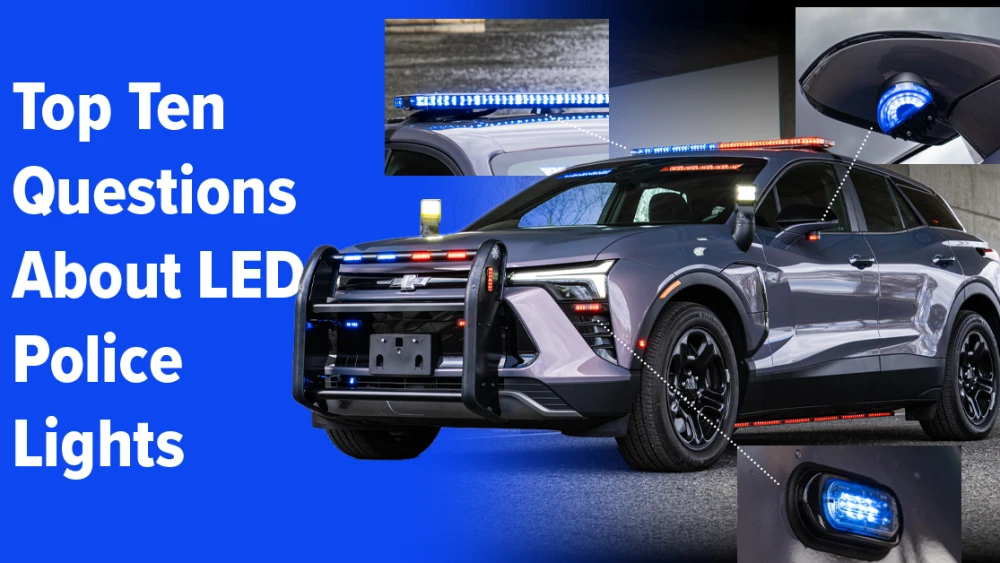Emergency lighting technology has evolved dramatically over the past century - from early halogen and strobe systems to today’s intelligent LED solutions. Modern LEDs deliver better performance, higher efficiency, and greater safety for officers and the public.
Whether you’re upgrading your fleet or just curious about how these systems work, here are the top ten questions we get about LED police lights.
Halogen and strobe lights were the first generation of emergency warning devices, dating back nearly 100 years. Halogen systems were easy on the eyes but offered low brightness (candela) and high-power draw, often requiring vehicles to stay running to keep the alternator powering the lights.
Strobes were a big step forward - they were brighter, used less power, and could flash faster - but they also produced high voltage, making them harsh on the eyes and more dangerous to service.
Today’s LED lighting combines the best of both: powerful brightness, low energy use, and superior control.
Modern LEDs have overcome the limitations of older technologies. They’re extremely bright, capable of high flash rates or low-intensity modes, and draw very little current from the vehicle’s electrical system.
When integrated with intelligent systems like Whelen’s Core® and Whelen Cloud Platform®, LED lights can automatically adapt based on environment, situational inputs, and geolocation - adjusting brightness, flash rate, and intensity so officers can stay focused on their mission while the lighting system works for them.
LEDs are built for longevity. With a lifetime expectancy of around 100,000 hours, a set of LED lights can last up to 22 years with 12 hours of daily use. That’s decades of dependable service with minimal maintenance or replacement costs.
Intelligent LED lighting systems increase safety by automatically adjusting to the environment. They can display bright, attention-grabbing patterns when visibility is critical, then dim in low-light or nighttime situations to prevent glare. LEDs can also serve as scene lighting when extra illumination is needed, improving visibility and situational awareness for everyone on scene.
Brightness and visibility depend on more than just output - it’s about control. Contrary to popular belief, lower-intensity, synchronized, and slower flash patterns can often make scenes safer. Studies have shown that these patterns improve visibility in poor weather and reduce stress for other drivers. Learn more HERE.
Leading manufacturers, including Whelen, conduct decades-long testing to ensure their lights meet strict performance and reliability standards. Every component - from the LEDs themselves to the housings, connectors, and circuit boards - is tested for durability against vibration, temperature extremes, and moisture.
Absolutely. LED lights can be configured for almost any application using specialized brackets, shields, custom housings, smoked lenses, and vehicle-specific mounts. Whether you’re outfitting a patrol car, motorcycle, or command vehicle, Whelen offers tailored solutions to meet unique fleet needs. Learn more about our law enforcement solutions.
Always verify that your lighting equipment meets SAE, NFPA, Title 13, and any other required local certifications. These standards ensure compliance and performance consistency. Check your manufacturer’s documentation or packaging, and when in doubt, contact your Whelen representative - they can help ensure your setup meets all applicable requirements.
Yes. Federal, state, and local regulations determine which colors and patterns are authorized for different agencies.
- Blue: Primarily used by law enforcement
- Red and White: Common for fire and EMS vehicles
- Amber: Typically used by tow, DOT, and construction vehicles
- Green: Used in some areas for command vehicles or snow operations due to its superior visibility in whiteout conditions
NFPA guidelines also specify minimum brightness levels, flash limits, and restrictions on white light facing rearward to maintain safety. Always make sure to check with your local authorities to ensure you are using the approved colors and patterns for your vehicle.
LEDs allow precise control over intensity and flash speed. Slower, synchronized patterns improve recognition distance and reduce stress for passing motorists. High-intensity modes are available for alerting in critical moments, while low-intensity options are ideal for stationary or nighttime scenes. This flexibility makes LEDs a powerful and adaptable tool for every response scenario.
The Bottom Line
LED technology has completely transformed emergency vehicle lighting. It offers unmatched reliability, efficiency, and adaptability - all while improving safety for officers and the communities they serve. From powerful light output to intelligent system integration, LEDs truly represent the future of public safety lighting.
Make the most of your LED lighting set up with Whelen Core! Learn more about it here or connect with a rep today!

